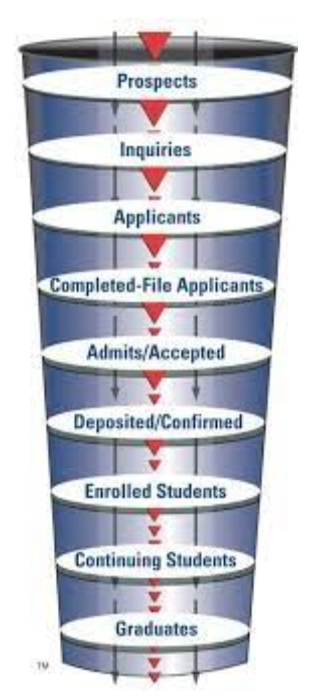
It has been said that all the world is simply a struggle between the “Haves” and “Have Nots.” How you view admissions and recruitment at your university probably depends a lot on which type of university you work at, whether you’re at a public, private, or for-profit institution, and—especially—what the mission of your institution looks like. Are you at one of the private “Haves” or perhaps one of the public “Have Nots?” Are your founding and mission based on access for a wide swath of the population, or is your purpose designed to serve the elite students—and only the elite students—who have risen to the top of the pyramid of academic achievement we sometimes call “merit?” It makes a big difference.
In my first post in this series, I wrote about marketing, and how all higher-education institutions do it to some degree. I also mentioned that the enrollment management and/or admissions/financial aid departments are leading the charge when it comes to the four components of marketing (price, product, place, and promotion). And in this post, we’ll get down to “brass tacks,” where we actually apply those concepts as we attempt to enroll a class in the next term that is of the appropriate size, quality, diversity, and ability to pay what the college expects in order to keep operations running.
Finally, amid all the uncertainty in how we do this, I’ll offer the only thing I can think of that is absolutely, positively true for all colleges and universities of all types in America.
It’s important to note that admissions and recruiting, while often conflated into one idea, are really separate entities, even though many (including myself) often mention them together. This post will focus on the recruiting part; the next post in this series will talk about admissions.
So, starting point:
When I talk about recruitment, I mean those activities that identify established and potential markets— whether they’re defined by student geography, diversity, ability to pay, academic interest, gender, age, or some other variable; that conduct research to understand and segment those markets; that deliver promotional information in a timely and effective way through a variety of channels; that track and measure interest; that engage the student market or sub-market via the most effective means; that work with students to overcome objections or obstacles; and that move students into the final step of the process, which is enrolling in the university.
Did you think it was just visiting high schools and going to college fairs and mailing literature? If you did, you’re not alone. That perception is largely driven by experience, and it’s possible that your experience with the college recruitment process was dominated by those things. It’s probably true that choosing a college has always been a somewhat complex process that’s mostly invisible to the average person, fraught with emotion and indecision, but anyone who has been in this business for even a couple of decades will tell you that it’s all different now.
The recruitment function is typically an 18- to 24-month process, and it depends on colleges filling the admissions funnel with the names and information of thousands—sometimes hundreds of thousands–of students. The traditional funnel starts with the assumption that each stage of the process narrows, with smaller and smaller numbers of students moving down the funnel from one stage to the next, as indicated in this graphic.
How these names enter the funnel in the first place varies: Some may be from lists of names acquired through College Board Student Search® or ACT EIS® services, where those testing agencies lease the names of students (with the student’s permission) to colleges who are interested. A public university in Missouri, for instance, might acquire the name of every high school graduate in the state, of certain segments of students in adjacent states, and highly targeted populations of students in other areas.
Other students may enter the process via self-initiated inquiries, like completing a form on the web, meeting with a college admissions staff member at their high school, or even telling the alumni office (via their parent, class of 1992) that they’d like to apply. Others, so-called “stealth applicants” (a term I don’t like) show up for the first time, previously unannounced, when they complete the application for admission. Try as we might, the students are still in charge of this part of the process.
But describing the recruitment funnel from the college’s standpoint fails an important marketing consideration: Empathy for the people in it. The phases of the funnel as commonly described (prospects or suspects, that is—those you suspect might be interested; inquiry, application, decision, etc.) categorize them as parts of a process. Once you’ve done real recruiting, you know that the emotions and motivations of students aren’t defined by how a college thinks of them, and if you try to force any prospective student into your business process, you’re going to come away disappointed. That’s why I have never liked the term “stealth applications,” for instance, because it assumes students should think and act the way we want, walking through that admissions funnel in a way that makes our lives easier. That’s not how this works—that’s not how any of this works, to quote the TV commercial.
(If you want to see this for yourself, I encourage you to ask your college’s director of admissions if you can accompany a staff member to a few high school visits or college fairs. Spend a week behind a table answering student and parent questions, and you’ll never think of this process the same way again.)
I prefer to think of the funnel from the student standpoint, because I believe when you do, the approach you take and the way you move students toward enrollment is a much more straightforward and obvious process.
I describe the recruitment process in a 7+3 framework. The first seven stages are what we typically think of as recruitment and admissions, and the last three (often outside of enrollment management’s control, but just as important) have to do with the post-enrollment processes. In order, they are:
Discernment: The stage where students are asking themselves about themselves, and thinking about the future. This is as true for a 27-year-old with two children and an associate’s degree who wants to return to college as it is for a 16-year-old sophomore in high school.
Discovery: Where students are being introduced to colleges that might be interested in them, without regard to whether they might be interested in the college.
Inspiration: That moment when something the student sees, hears, reads, or experiences makes them excited or interested in a college, or sometimes, in the idea of college. This, of course, might occasionally come before the discernment step. Again, every student is different, which makes this work hard.
Inquiry: Where a student decides they need to know more and feels comfortable approaching a college.
Application: The point a student narrows down the list and says, “I think I might want to enroll.”
Decision: The point that’s often the most tenuous in the mind of the student: A denial or a waitlist can be disappointing, and an email or letter of admission can be exhilarating.
Enrollment: That point when a student makes a commitment.
The last three: persistence, graduation, and alumni status, are a topic for another day.
The process of recruitment can be highly aggressive and data-driven, or more passive, and this too is largely dependent on mission and history. If your university is highly tuition-dependent, if you want to increase selectivity, if your college is not well-known but trying to open new markets, or if you need to be very sensitive to the mix of wealthy and needy students, you might acquire the names of half-a-million students and run them through a sophisticated database-driven marketing routine that would be the envy of some businesses.
Running sophisticated econometric models to help determine what your class might look like next fall, or trying to figure out where certain incremental effort might yield results, has transformed the recruitment process in the last 20 years. If you’re a small institution and can’t hire the staff to effect these operations, there are now dozens of companies that do this work on behalf of hundreds of institutional clients throughout the landscape of higher education. (I refer to this collection of businesses and the services they sell as “The Admissions Industrial Complex.”)
If you’re largely an open-access institution with small geographic or demographic draw, or you enroll mostly commuter or part-time students, or those over the age of 25, your process might be more passive, and your recruitment efforts might be less sophisticated or data-driven; this also means that your results are largely a function of those things in the markets you cannot control, such as the population of your county, or the closing of a local factory.
Of course, these are extremes, and your reality probably lies somewhere between the two.
I’m occasionally asked about how all of this has changed in the 40 years I’ve been doing this, and there are some obvious—even silly—things that jump out at first: Traveling for recruitment in the early 80s meant scheduling appointments by phone, traveling with paper airline tickets, navigating with paper maps and handwritten directions from previous staff members, and of course, no cell phones. And I often remark that before my first recruiting trip ever, I had to go to Target and buy a hair dryer, an appliance I’ve not used in a long, long time. But most of those changes are the things we all feel and experience.
What’s really changed is the extent to which we as admissions or enrollment professionals are in charge of things. Clearly, we can now easily segment our data in seconds, measure who read the email we sent last night and when, track visits to our student portals, understand what people are searching for when they visit our websites, and use the information to persuade ourselves that we’re in control.
We’re not in control.
Thirty years ago, information about our university was controlled by us: If a student wanted to find out about our academic offerings or admissions requirements, they’d have to call, or write, or fill out a card, or stop by campus. We knew who had requested information, and that information we provided had been curated, distilled, and printed with great care to control the image and the impression we wanted to present.
Now, the information we create to promote ourselves is only a fraction of what students, parents, and counselors have access to. A student touring campus can record the whole thing in HD video, upload it to the Internet, and add their own running commentary and observations (some good, of course, but some presenting a less-than-ideal picture). Popular websites allow parents and students to share impressions, ask questions, and compare financial aid offers. As with all the information on the web, some of it is very good—and some of it is very, very bad.
So, no, the recruitment process is not just about visiting high schools and attending college fairs and hosting open houses. In fact, those things have been becoming less important for some time, and the great disrupter of the 21st Century (COVID-19) has made them even less critical to our efforts. Modern recruitment depends heavily on data and information and the insight they yield, and our current interactive channels are evolving all the time. Like the move from paper maps to GPS, the real change is only visible over longer time frames, and in retrospect. Our channels include not just email, printed materials, and personal interaction, but also YouTube ads and search engine optimization and Google appliances.
I promised to share the only thing I can think of that is absolutely, positively true for all colleges and universities of all types in America. So here it is: If you can’t get the student to apply for admission, they will never enroll.
Check back in five years for an update. It will all be different—except, I expect, for that one thing.
And check back (when?) for my next blog post, which will be on a related and yet separate topic: the college admissions process.


